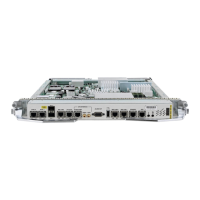subscription signaling uses IGMP to include mode membership reports, which are supported only in Version
3 of IGMP (IGMPv3).
To run SSM with IGMPv3, SSM must be supported on the multicast router, the host where the application is
running, and the application itself. Cisco IOS XR Software allows SSM configuration for an arbitrary subset
of the IP multicast address range 224.0.0.0 through 239.255.255.255. When an SSM range is defined, existing
IP multicast receiver applications do not receive any traffic when they try to use addresses in the SSM range,
unless the application is modified to use explicit (S,G) channel subscription.
PIM-Bidirectional Mode
PIM BIDIR is a variant of the Protocol Independent Multicast (PIM) suite of routing protocols for IP multicast.
In PIM, packet traffic for a multicast group is routed according to the rules of the mode configured for that
multicast group. In bidirectional mode, traffic is only routed along a bidirectional shared tree that is rooted at
the rendezvous point (RP) for the group. In PIM-BIDIR, the IP address of the RP acts as the key to having
all routers establish a loop-free spanning tree topology rooted in that IP address. This IP address does not
need to be a router, but can be any unassigned IP address on a network that is reachable throughout the PIM
domain. Using this technique is the preferred configuration for establishing a redundant RP configuration for
PIM-BIDIR.
In Cisco IOS XR Release 4.2.1, Anycast RP is not supported on PIM Bidirectional mode.Note
PIM-BIDIR is designed to be used for many-to-many applications within individual PIM domains. Multicast
groups in bidirectional mode can scale to an arbitrary number of sources without incurring overhead due to
the number of sources. PIM-BIDIR is derived from the mechanisms of PIM-sparse mode (PIM-SM) and
shares many SPT operations. PIM-BIDIR also has unconditional forwarding of source traffic toward the RP
upstream on the shared tree, but no registering process for sources as in PIM-SM. These modifications are
necessary and sufficient to allow forwarding of traffic in all routers solely based on the (*, G) multicast routing
entries. This feature eliminates any source-specific state and allows scaling capability to an arbitrary number
of sources.
The traditional PIM protocols (dense-mode and sparse-mode) provided two models for forwarding multicast
packets, source trees and shared trees. Source trees are rooted at the source of the traffic while shared trees
are rooted at the rendezvous point. Source trees achieve the optimum path between each receiver and the
source at the expense of additional routing information: an (S,G) routing entry per source in the multicast
routing table. The shared tree provides a single distribution tree for all of the active sources. This means that
traffic from different sources traverse the same distribution tree to reach the interested receivers, therefore
reducing the amount of routing state in the network. This shared tree needs to be rooted somewhere, and the
location of this root is the rendezvous point. PIM BIDIR uses shared trees as their main forwarding mechanism.
The algorithm to elect the designated forwarder is straightforward, all the PIM neighbors in a subnet advertise
their unicast route to the rendezvous point and the router with the best route is elected. This effectively builds
a shortest path between every subnet and the rendezvous point without consuming any multicast routing state
(no (S,G) entries are generated). The designated forwarder election mechanism expects all of the PIM neighbors
to be BIDIR enabled. In the case where one of more of the neighbors is not a BIDIR capable router, the election
fails and BIDIR is disabled in that subnet.
Cisco ASR 9000 Series Aggregation Services Router Multicast Configuration Guide, Release 5.1.x
10
Implementing Layer-3 Multicast Routing on Cisco IOS XR Software
Protocol Independent Multicast

